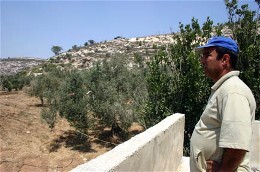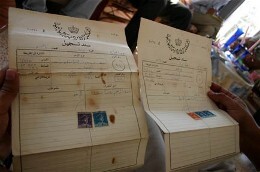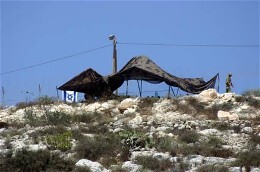
Nizar Sayf looking over his farm with Homesh looming in the background (Ben Granby)
According to its municipality, Burqa once boasted a population of over 30,000, but numerous pressures induced people to emigrate to Nablus, which lies about 10 km to the south. Not least of these were the settlements that sprung up atop the hills north of Nablus in 1980, including Shavei Shomron and Homesh, which confiscated land and consumed valuable water resources upon which the local Palestinian farmers depended.
Homesh, which sits just above Burqa, was established as a military base in the mid-1970s when the land on which it lies was confiscated by the Israeli Army, with no compensation to the owners of the property. Israeli settlers, mostly secular, began moving in as it was completely legal in Israeli law until 1991 for settlements to be build on Palestinian private property. During the current Intifada, the main Jenin-Nablus highway Route 60 was continually closed off to Palestinian drivers, forcing people to take long and circuitous routes through the hills. After several militant ambushes against Homesh’s settlers, many of the secular community fled, only to be replaced by more religious zealots who often harassed Burqa’s residents and often threatened and attacked farmers in their fields.

Nizar Sayf’s Jordanian deeds verifying his father Yusef’s purchase of the land now occupied by the Israeli settlement Homesh (Ben Granby)
Nizar Sayf and his friends spend the afternoon of the evacuation casually musing the operation while watching from a distance. “I couldn’t sleep at all last night,” Nizar laments, “the army was in every field looking for [settler infiltrators] trying to reach Homesh.” Calls between neighbors bounce around through the day. “Are they army?” Nizar asks of another Burqa resident who observed some people lurking through his groves. Just above Nizar’s home, a few Israeli soldiers keep watch in some bushes as an observation balloon floats nearby.
But that is about as exciting as things get. The reality for the people of Burqa is that at best, the evacuation of Homesh will only mean the end to harassment from settlers. But with the Israeli Army transitioning the settlement back into a military base, there is no assurance that any land or water resources will return to village control.

An Israeli army outpost above Burqa village (Ben Granby)
While Shlomo Dror, of the Coordinator for Government Activities in the Territories, stated in the Jerusalem Post on August 24 that the expanded military confiscations are only temporary, there is no indication that the rest of Homesh will return to Burqa anytime soon. “I learned one thing over the years,” Nizar continues while gazing across his fields. “Never trust the Israeli Army.” He adds that the original military base on the hill was also supposedly temporary.
“If the Israelis fully leave, we can begin to build factories, bring in investments from overseas,” Nizar fantasizes, his eyes lighting up. “We can bring the nearby villages together and build a city!”



